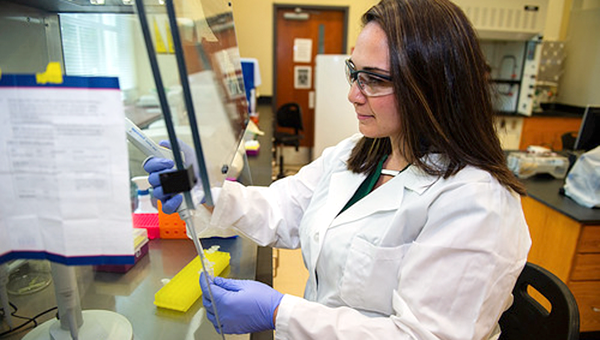AU team locates Zika- transmitting species in Alabama
Published 1:01 am Thursday, June 7, 2018

- Auburn University Assistant Professor Sarah Zohdy and her research team have documented the existence of the Aedes aegypti mosquito, a known transmitter of the Zika virus, in Mobile County, Alabama, for the first time in 26 years. (Photo by Philip Smith)
Auburn University researchers have discovered the presence of Aedes aegypti—the primary mosquito that transmits Zika virus, yellow fever and other flaviviruses—in Alabama.
After a 26-year absence, Auburn School of Forestry and Wildlife Sciences Assistant Professor of Disease Ecology Sarah Zohdy and wildlife sciences undergraduate student Victoria Ashby have discovered the species in Mobile. Ae. aegypti was thought to have been eliminated from the state. “Our CDC-funded research has not only allowed for the detection and molecular confirmation of the mosquito in the state, but over the last year we have documented the spread of the mosquito from central Mobile to all of Mobile County,” Zohdy said.
The study was conducted from July 2016 to September 2017. A total of 1,074 mosquitoes were collected, with Ae. aegypti being detected most commonly in the 36606 area code of southwest Mobile, where there were more open containers than any other area in the city.
The detection of Ae. aegypti confirms that Alabama residents could be at risk to contract several mosquito-transmitted diseases. “This work demonstrates that citizens of Alabama may be exposed to the mosquito vector of Zika, chikungunya and Dengue fever viruses,” Zohdy said.
Zika virus spreads to people primarily through the bite of an infected Aedes species mosquito (Ae. aegypti and Ae. albopictus). Female mosquitoes become infected by ingesting microbes from a person’s blood while biting them and then passing those microbes to the next person’s blood stream. Once infected, the mosquito is then thought to remain infected and able to pass on the virus throughout the remainder of its life, or about two to four weeks. During this period they may take three to four blood meals, biting up to four or five people during their lifespan. Ae. aegypti is particularly problematic because it will also bite during the day and is very adaptive to different environments.

A research team has documented the existence of the Aedes aegypti mosquito in Mobile County for the first time in 26 years.
(Photo courtesy of CDC)
Specific geographic areas of greatest risk are correlated to the existence of the Aedes species. The Centers for Disease Control and Prevention, or CDC, has developed estimated-range maps using models that predict potential geographic ranges where the Zika-transmitting mosquitoes would likely survive and reproduce based on local and historical records and suitable climate variables. According to the 2017 maps, the Zika-transmitting mosquito species are very likely to exist throughout the southeastern U.S. and as far west as California and as far north as Delaware.
Despite the state of Alabama being an ideal habitat for mosquitoes that transmit Zika virus, very little mosquito surveillance data has been collected from around the state. Zohdy said that because of their research efforts and the discovery of Ae. aegypti, her team is now working with the Alabama Department of Public Health.
According to the CDC, there were 449 symptomatic Zika virus disease cases reported within the U.S. in 2017, with three reported in Alabama and two in Georgia. The majority of cases were instances of travelers contracting the disease from affected areas. Seven cases were acquired through presumed local mosquito-borne transmission, including two in Florida and five in Texas.
Zohdy’s team is now conducting research in all 67 counties in Alabama to determine how widespread Ae. aegypti andAe. albopictus are across the state.
In an effort to crowd-source mosquito surveillance data around the state, Zohdy’s research team has partnered with Prakash Lab at Stanford University to develop and implement an app called “Abuzz,” which will allow Alabama citizens to record the sound of a mosquito flying. From this recording, the app can identify the species of mosquito and whether or not that species could potentially carry a disease by the sound of the buzzing of its wings.
Once deployed, the app can empower volunteer “citizen scientists” to participate in mosquito surveillance to help researchers increase the volume and locations of data collection. “Alabama has had little mosquito surveillance in the past and we hope this app can change that to make it the best sampled state in the nation,” Zohdy said.
Zohdy and her team also surveyed Mobile residents to gain insight about their perceptions of Zika virus and the best ways to target mosquito prevention. Of those responses, 70 percent reported a moderate to very high density of mosquitoes in their home and over half of those surveyed said they feel concerned to extremely concerned that they or a family member might contract Zika virus.
“To help mitigate the threat of the Zika virus it is critical to understand local knowledge and behavioral factors related to exposure to the mosquitoes,” said Wayde Morse, an Auburn School of Forestry and Wildlife Sciences associate professor of human dimensions, who participated in the research efforts.
The results of the research efforts were published April 5 in the Journal of Medical Entomology, a scientific journal that historically publishes important information regarding mosquito surveillance. “Having this research published is a good way to reach people who study mosquitoes and other disease vectors,” Zohdy said.
Victoria Ashby, a sophomore studying wildlife sciences with a pre-veterinary medicine concentration, has worked with Zohdy’s research team for over a year and now leads fieldwork efforts. “My fieldwork has consisted of biweekly trips down to the Mobile Bay area in order to aspirate for adult mosquitoes and collect larvae using larval dip cups at 25 different sites in 12 zip codes,” she said.
After graduation, Ashby plans to attend graduate school to continue on the path of disease ecology research and later attend veterinary school. “I have a strong interest in veterinary epidemiology and public health and throughout my time so far at Auburn, my involvement in the disease ecology lab with Dr. Zohdy has really shaped my academic interests and ambitions,” she said.
Though Zika virus is primarily spread by infected Aedes species mosquitoes, the disease can also be transmitted through sexual contact with an infected person or from an infected pregnant woman to her fetus during pregnancy or at birth.
To report suspected illness or to learn more about mosquito-borne disease prevention methods, visithttps://www.cdc.gov/zika/.




